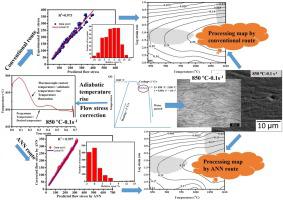Materials Today Communications ( IF 3.8 ) Pub Date : 2020-12-04 , DOI: 10.1016/j.mtcomm.2020.101903 Sumit Kumar , Anish Karmakar , Sumeer K. Nath

|
The behavior of hot deformed flow curves in a 9Cr-1Mo steel have been analysed using constitutive and artificial neural network (ANN) approaches. At each temperature (850 C-1100 C) various strain rates (0.001 s−1–10 s−1) of deformation behavior has been analysed. The corrections of flow stress due to the adiabatic temperature rise during hot deformation have been made through artificial neural network (ANN) method and compared it with the linear interpolation (conventional) method. The temperature corrected (conventional) flow stress has been compared and analyzed with the predicted flow stress data obtained by established constitutive equation. Additionally, the experimental flow stresses obtained by thermomechanical simulator have also been compared and analyzed with predicted flow stresses obtained by ANN method. Further, the predicted and corrected flow stress curves obtained by ANN method have been compared and analyzed. The processing maps at 0.6 true strain based on flow stress data corrected through both ANN and conventional methods have been compared. Upon analyzing the safe and unsafe domains of the maps with the corresponding microstructures, the ANN approach depicted the best precise results over that of the conventional method. Variation in strain hardening rate and correlated it with EBSD analysis have also been carried out to analyze the variation in hardness for some of the deformed specimens.
中文翻译:

通过常规方法和人工神经网络方法构造9Cr-1Mo钢的热变形加工图
使用本构和人工神经网络(ANN)方法分析了9Cr-1Mo钢中热变形流动曲线的行为。在每个温度(850 C-1100 C)各种应变率(0.001 s -1 –10 s -1)的变形行为已被分析。已经通过人工神经网络(ANN)方法对由于热变形过程中绝热温度升高而引起的流应力进行了校正,并将其与线性插值(常规)方法进行了比较。已对温度校正(常规)流应力进行了比较,并与通过建立的本构方程获得的预测流应力数据进行了比较。此外,还对通过热机械模拟器获得的实验流动应力与通过ANN方法获得的预测流动应力进行了比较和分析。此外,对通过人工神经网络方法获得的预测和修正后的流动应力曲线进行了比较和分析。比较了基于ANN和常规方法校正的流应力数据在0.6真实应变下的处理图。通过分析具有相应微观结构的地图的安全区域和不安全区域,ANN方法比传统方法具有最佳的精确结果。还进行了应变硬化率的变化并将其与EBSD分析相关联,以分析某些变形试样的硬度变化。



























 京公网安备 11010802027423号
京公网安备 11010802027423号